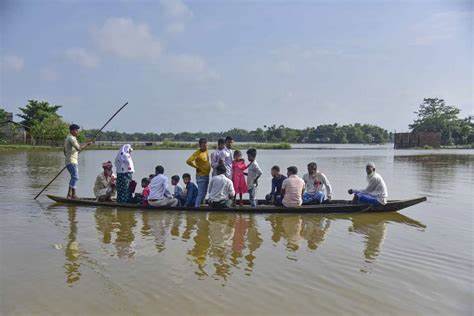Assam, a state accustomed to annual monsoon floods, is currently reeling under a severe humanitarian crisis as floodwaters continue to wreak havoc across its vast landscape. The latest reports indicate that over 2.2 million people have been affected by the floods, with the death toll tragically climbing to 62. This ongoing catastrophe has once again highlighted the vulnerability of Assam’s communities to seasonal flooding and underscored the urgent need for robust disaster management strategies and infrastructure development in the region.
The annual monsoon season in Assam typically brings heavy rainfall, swelling rivers, and inundating low-lying areas. While floods are a recurrent phenomenon, the scale and intensity of this year’s deluge have been particularly devastating. The Brahmaputra River and its tributaries, which traverse the state, have overflowed their banks, submerging villages, farmlands, and towns in their path.
As the floodwaters continue to rise, the plight of affected communities has worsened. Reports from across Assam paint a grim picture of widespread displacement, loss of homes, destruction of crops, and disruptions in essential services. Relief camps have been set up to shelter thousands of displaced families, providing them with basic amenities and medical assistance amidst challenging conditions.
The human toll of the floods is deeply distressing, with reports confirming 62 fatalities across the state. Tragically, these casualties include men, women, and children who lost their lives either in flood-related incidents or due to the precarious conditions exacerbated by the inundation. Rescue and relief operations have been intensified to reach remote and isolated areas where communities remain stranded and in urgent need of assistance.
Government agencies, disaster response teams, and local authorities have been mobilized to manage the crisis and provide relief to affected populations. The Assam State Disaster Management Authority (ASDMA) has been coordinating rescue efforts, distributing relief materials, and ensuring the safety of vulnerable communities. However, the sheer scale of the disaster has stretched resources and posed logistical challenges in reaching all affected areas promptly.
The floods have also taken a severe toll on Assam’s agricultural sector, which forms the backbone of the state’s economy. Large swathes of farmland have been submerged, leading to substantial crop losses and threatening food security for local communities. Livestock, essential for many rural families’ livelihoods, have also been severely affected, further exacerbating economic hardships in flood-affected regions.
Beyond immediate relief efforts, the floods in Assam have reignited discussions about long-term solutions to mitigate the impact of recurring natural disasters. Experts emphasize the importance of comprehensive flood management strategies, including the construction and maintenance of robust embankments, dredging of rivers, and implementation of early warning systems to alert communities in advance of impending floods.
Moreover, climate change has been identified as a significant factor exacerbating the frequency and intensity of floods in Assam and other regions of India. Rising global temperatures contribute to erratic weather patterns, increasing the likelihood of extreme rainfall events and subsequent flooding. Addressing climate change through mitigation and adaptation measures is therefore crucial to reducing the vulnerability of Assam’s communities to future disasters.
In response to the crisis, humanitarian organizations, civil society groups, and volunteers have rallied to support government efforts and provide assistance to flood-affected populations. Their contributions, ranging from relief supplies to medical aid and psychosocial support, play a vital role in complementing official relief efforts and meeting the diverse needs of affected communities.
As Assam continues to grapple with the aftermath of the devastating floods, the focus remains on ensuring the safety and well-being of all affected residents. Efforts must also be directed towards rebuilding infrastructure, restoring livelihoods, and strengthening resilience against future calamities. The resilience and solidarity demonstrated by communities and relief agencies amidst adversity offer hope for recovery and renewed efforts towards sustainable development in flood-prone regions like Assam.
In addition, the floods in Assam have inflicted widespread devastation, affecting millions of lives and claiming numerous casualties. While immediate relief efforts are underway, the long-term focus must be on implementing effective flood management strategies, addressing climate change impacts, and building resilient communities capable of withstanding future natural disasters.




